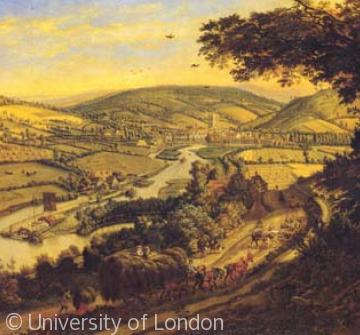Jan Siberechts and Henley

Image: Henley from the Wargrave Road (1698), by Jan Siberechts; courtesy of the River & Rowing Museum, Henley on Thames
During the 1690s the Flemish landscape painter Jan Siberechts (1627-c.1700) produced several enigmatic views of Henley and the River Thames. Unlike most such paintings, which celebrated the wealth and prestige of a particular landowner, the Henley series focuses on no single estate or country house and encompasses various viewpoints, subjects and moods. Most display a finely observed emphasis on the commercial and agricultural life of the area: Henley with its wharves, market and malt houses, the surrounding countryside with its fields, pastures and woodland, and above all the Thames as a working waterway, with its flashlocks, barges and cargoes. This suggests that the patrons were people with a commercial interest in the area, rather than the aristocrats and landowners who most commonly commissioned such landscapes. Since 2001, research into the ownership of the various lands shown, combined with careful examination of the paintings themselves, has gone some way to unravelling the mystery, revealing a complex mesh of political, financial and family ties amongst local landowners, Thames merchants, and City lawyers and financiers. Siberechts clearly moved in similar circles, cultivating not only aristocrats but merchants and lesser landowners to win his commissions. One of the most famous paintings (above) is now thought to be associated with the Drapers, a well-connected mercantile family which acquired the Park Place estate (south-east of Henley) in the 1630s. Family members certainly commissioned work from fashionable artists and craftsmen including Dutch painters, and this view from Marsh Lock up the river to Henley is taken from their lands, celebrating the commercial life of town and countryside. The elaborate draperies and textiles visible on figures in the foreground may be a pun on the family name. Probably it formed part of a pair with a companion view from the north-east (now in the Tate Gallery), and there may originally have been a lost central painting showing Park Place. Another in the series (A Prospect of the Thames near Henley) was probably commissioned in 1697 by the wealthy London banker Sir Robert Clayton, and depicts the Thames-side estates in which he obtained an interest through skilful mortgaging and financial manoeuvering. Siberechts' minute detail parallels the rigorous land-surveying which made people like Clayton so successful, and probably appealed to these commercially-minded merchants, bankers and estate-managers. By contrast, the more lyrical and poetic of the Henley views may have been commissioned by local aristocracy such as the Lovelaces at Hurley, or the duke of Buckingham at Cliveden. For some other Siberechts paintings see the Tate Britain website. Sources and Further Reading: Laura Wortley, 'Jan Siberechts in Henley-on-Thames', Burlington Magazine 149 (March 2007), 148–57; Laura Wortley, 'City Merchants' Landownership around Henley-on-Thames and the Paintings of Jan Siberechts', in M. Galinou (ed.), City Merchants and The Arts 1670–1720 (2004), 93–102; K. Hearn, 'Merchant Clients for the Painter Jan Siberechts', in ibid. 83–92.
Content generated during research for the paperback book 'Henley-on-Thames: Town, Trade and River' (ISBN 13 : 978-1-86077-554-3) for the England's Past for Everyone series

